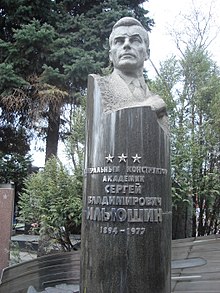Sergei Vladimirovich Ilyushin

Sergey Ilyushin ( Russian Сергей Владимирович Ильюшин , scientific. Transliteration Sergei Vladimirovič Iljušin * 18 . Jul / 30th March 1894 greg. In Diljalewo in Vologda ; † 10. February 1977 in Moscow ) was a Soviet engineer, aircraft manufacturer and designer of Russian Nationality.
Life
Sergei Ilyushin was the youngest of nine children of the farmer Vladimir Iwanowitsch Ilyushin and his wife Anna Wassiljewna Ilyushina. From the age of nine to twelve he attended school in the neighboring village of Berezniki. At the age of 15 he worked as an unskilled worker in various positions.
After the outbreak of World War I , Ilyushin was drafted into the military in 1914 and trained as an aircraft mechanic, including on the Ilya Muromets bomber plane . At his own request, he went through in Petersburg , a pilot training and put in the summer of 1917, the flight exam. In May 1919 he switched to the newly formed Red Army and joined the Communist Party . In the civil war that followed , he again served as an aircraft mechanic on the northern front, and later in the Saratov aircraft workshop .
On September 21, 1921 Ilyushin enrolled at the Moscow Military Academy for Air Force Engineers “Prof. NJ Zhukovsky ” . His professors included the helicopter designer Boris Nikolajewitsch Jurjew and the aerodynamicist Vladimir Petrovich Wettschinkin . During his studies Ilyushin designed his first glider AWF-3 "Mastjaschart" with a wingspan of nine meters in 1923 , which took part in the 1st Soviet glider competition in the Crimea near Koktebel . In 1924 the AWF-4 "Rabfakowjez", the AWF-5 "Mastjaschart 2" and the AWF-14 followed. The most successful model during his studies was the AWF-21 "Moskwa", developed under the guidance of the two designers N. N. Leontjew and L. S. Kudrin, which took part in the annual Rhön gliding competition in Germany in 1925 and set a record in endurance flight. In 1926 Ilyushin finished his studies with a diploma for aircraft construction.
Then Ilyushin went back to the army as a member of the Scientific and Technical Committee of the Air Force Administration (NTK UWWS) and later became its chief designer. In 1930 he moved to the Scientific Test Institute and in August 1931 to ZAGI , where he was appointed head of his own design office. There he dealt with the construction of the altitude research balloon "SSSR". In 1933 he joined the designers Nikolai Polikarpow , Dmitri Grigorowitsch and Sergei Kotscherigin in the Menschinskowo plant and founded his own ZKB (Central Design Office). There the ZKB-26 was created, which was later renamed the Ilyushin Il-4 and set several world records. On August 17, 1936, the ZKB was officially renamed OKB (Experimental Design Office) Ilyushin. In addition to his work as a designer, Ilyushin was director of the Aviation Industry Department (GUAP) in the People's Commissariat for Heavy Industry (NKTP) from 1937 to February 1938.
On April 21, 1938, Ilyushin was on a flight aboard the Yakovlev- designed AIR-11 from Moscow to Voronezh when the engine failed. During the forced landing he suffered severe head injuries that marked him for the rest of his life.
The big breakthrough came in 1939 with the Ilyushin attack aircraft Ilyushin Il-2 , with about 36,000 copies of the most produced aircraft in the world. After the war, Ilyushin began developing the Ilyushin Il-12 airliner (first flight in 1945) and some bomber designs, of which only the Il-28 was ready for series production. Among its constructions stand out:
- the Ilyushin Il-10 attack aircraft
- the Ilyushin Il-14 passenger plane
- the Ilyushin Il-18 turboprop medium- haul airliner (four PTL , 1956)
- the Ilyushin Il-28 bomber
- the long-haul airliner Ilyushin Il-62 (four ZTL , 1962)
- one of the largest transport aircraft in the world Ilyushin Il-76 (four ZTL, up to 52 t payload, 1971)
Since 1948 he had a professorship at the Aviation Military Academy . In 1967 he was appointed Colonel-General Engineer of the Aviators, and the following year he was made a member of the Academy of Sciences of the USSR . He was a deputy of the Supreme Soviet of the USSR in the first to seventh legislative periods. Ilyushin's last aircraft was the Ilyushin Il-86 .
Ilyushin received numerous awards from the Soviet Union for its designs. He was eight times winner of the Order of Lenin , the Order of the Red Banner of Labor (1933), received the State Prize seven times (1941, 1942, 1943, 1946, 1947, 1950, 1952), twice the Order of the Red Star , and was awarded three times (1941 , 1957 and 1974) decorated with the Order of Hero of Socialist Labor . He received the Lenin Prize in 1960.
His son, Vladimir Ilyushin , was a well-known test pilot.
literature
- Rudolf Höfling: Ilyushin. Aircraft since 1933 . Motorbuch, Stuttgart 2013, ISBN 978-3-613-03604-8 .
- P. T. Astashenko: Ilyushin and his planes . Transpress, Berlin 1976 (Russian: Конструктор легендарных илов . Moscow 1970. Translated by Holger Luckas).
Individual evidence
- ^ Wilfried Copenhagen: transpress-Lexicon aviation. transpress, Berlin 1979. p. 286
| personal data | |
|---|---|
| SURNAME | Ilyushin, Sergei Vladimirovich |
| ALTERNATIVE NAMES | Ильюшин, Сергей Владимирович; Iljušin, Sergej Vladimirovič |
| BRIEF DESCRIPTION | Russian engineer and aircraft manufacturer |
| DATE OF BIRTH | March 30, 1894 |
| PLACE OF BIRTH | Diljalewo near Vologda |
| DATE OF DEATH | February 10, 1977 |
| Place of death | Moscow |
